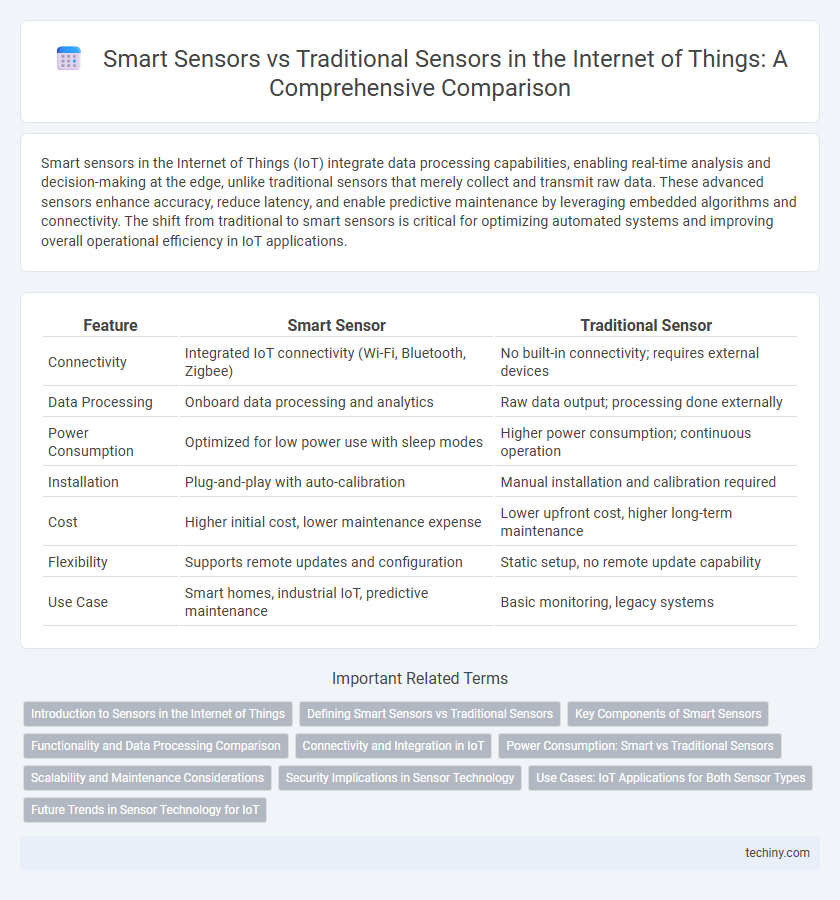Smart sensors in the Internet of Things (IoT) integrate data processing capabilities, enabling real-time analysis and decision-making at the edge, unlike traditional sensors that merely collect and transmit raw data. These advanced sensors enhance accuracy, reduce latency, and enable predictive maintenance by leveraging embedded algorithms and connectivity. The shift from traditional to smart sensors is critical for optimizing automated systems and improving overall operational efficiency in IoT applications.
Table of Comparison
| Feature | Smart Sensor | Traditional Sensor |
|---|---|---|
| Connectivity | Integrated IoT connectivity (Wi-Fi, Bluetooth, Zigbee) | No built-in connectivity; requires external devices |
| Data Processing | Onboard data processing and analytics | Raw data output; processing done externally |
| Power Consumption | Optimized for low power use with sleep modes | Higher power consumption; continuous operation |
| Installation | Plug-and-play with auto-calibration | Manual installation and calibration required |
| Cost | Higher initial cost, lower maintenance expense | Lower upfront cost, higher long-term maintenance |
| Flexibility | Supports remote updates and configuration | Static setup, no remote update capability |
| Use Case | Smart homes, industrial IoT, predictive maintenance | Basic monitoring, legacy systems |
Introduction to Sensors in the Internet of Things
Smart sensors in the Internet of Things (IoT) integrate processing capabilities and communication features, enabling real-time data collection and transmission for enhanced automation and monitoring. Traditional sensors primarily measure physical parameters and require external devices for data processing and connectivity, limiting their standalone functionality. The shift towards smart sensors drives improved efficiency, accuracy, and scalability in IoT applications across various industries.
Defining Smart Sensors vs Traditional Sensors
Smart sensors integrate built-in processing capabilities, enabling real-time data analysis and communication within the Internet of Things (IoT) ecosystem, unlike traditional sensors that solely capture raw data requiring external processing. These intelligent devices combine sensing elements with microprocessors, offering enhanced accuracy, adaptability, and autonomous decision-making. Traditional sensors typically depend on separate systems for data interpretation, limiting their functionality in dynamic and interconnected environments.
Key Components of Smart Sensors
Smart sensors integrate sensing elements with microprocessors, enabling data processing, signal conditioning, and communication within a single unit, unlike traditional sensors that only measure physical parameters. Key components include the sensing element, microcontroller, memory, communication interface (such as Bluetooth or Wi-Fi), and power management systems, facilitating real-time data analytics and remote monitoring. These integrated features allow smart sensors to deliver enhanced accuracy, self-diagnostics, and interoperability critical for advanced Internet of Things (IoT) applications.
Functionality and Data Processing Comparison
Smart sensors integrate embedded processors for real-time data analysis and decision-making, enhancing functionality beyond simple signal detection found in traditional sensors. They enable edge computing, reducing latency and bandwidth use by processing data locally, whereas traditional sensors rely on external devices for data interpretation. This advanced data processing capability allows smart sensors to support predictive maintenance, adaptive control, and improved accuracy in Internet of Things (IoT) applications.
Connectivity and Integration in IoT
Smart sensors in IoT feature embedded connectivity protocols like Wi-Fi, Zigbee, and Bluetooth, enabling real-time data transmission and seamless integration with cloud platforms for advanced analytics. Traditional sensors typically rely on wired connections or standalone data collection, limiting their ability to integrate directly with IoT networks. Enhanced integration of smart sensors allows for automated decision-making and remote device management, driving smarter and more efficient IoT ecosystems.
Power Consumption: Smart vs Traditional Sensors
Smart sensors in the Internet of Things (IoT) significantly reduce power consumption by integrating data processing and energy-efficient communication protocols, unlike traditional sensors that rely on continuous data transmission and external processing. Advanced features like adaptive sampling and low-power wireless technologies in smart sensors extend battery life, enabling longer deployment in remote or inaccessible locations. Traditional sensors often cause higher energy drain due to constant operation and lack of on-device intelligence, limiting their usability in power-sensitive IoT applications.
Scalability and Maintenance Considerations
Smart sensors in the Internet of Things (IoT) ecosystem offer superior scalability compared to traditional sensors due to their built-in processing capabilities and wireless connectivity, enabling seamless integration and real-time data management across large networks. Maintenance is more efficient with smart sensors as they support remote diagnostics, firmware updates, and predictive analytics, reducing downtime and operational costs. Traditional sensors require manual calibration and physical access for troubleshooting, limiting scalability and increasing maintenance complexity in expansive IoT deployments.
Security Implications in Sensor Technology
Smart sensors in the Internet of Things (IoT) integrate advanced encryption and authentication protocols, significantly reducing vulnerability to unauthorized access compared to traditional sensors. Traditional sensors often lack built-in cybersecurity measures, making them susceptible to data breaches and manipulation. The robust security features of smart sensors enhance data integrity and protect critical infrastructure from potential cyber threats.
Use Cases: IoT Applications for Both Sensor Types
Smart sensors enable real-time data processing and remote monitoring in IoT applications such as smart homes, healthcare, and industrial automation, enhancing efficiency and predictive maintenance. Traditional sensors primarily serve basic data collection roles in environmental monitoring and simple control systems, relying on external processing units for analysis. The integration of smart sensors in IoT ecosystems allows for advanced functionalities like adaptive response and decentralized decision-making, which traditional sensors lack.
Future Trends in Sensor Technology for IoT
Smart sensors integrate processing capabilities and wireless communication, enabling real-time data analytics and autonomous decision-making in IoT ecosystems, unlike traditional sensors which only capture raw data. Future trends indicate widespread adoption of AI-enhanced smart sensors with edge computing to reduce latency and improve efficiency in IoT applications. Advanced materials and energy harvesting technologies are expected to further enhance sensor durability and sustainability for long-term IoT deployment.
Smart sensor vs Traditional sensor Infographic

 techiny.com
techiny.com